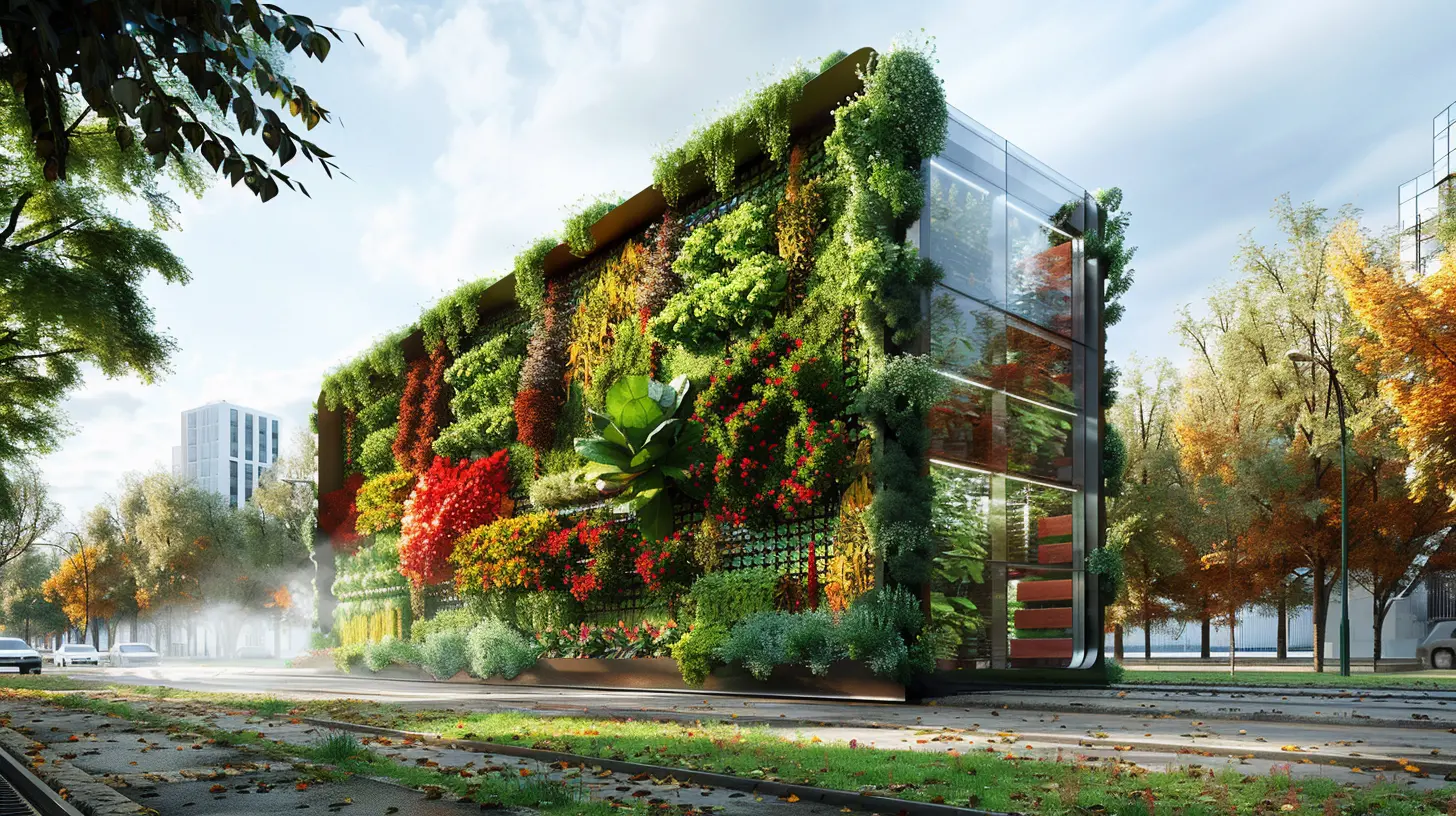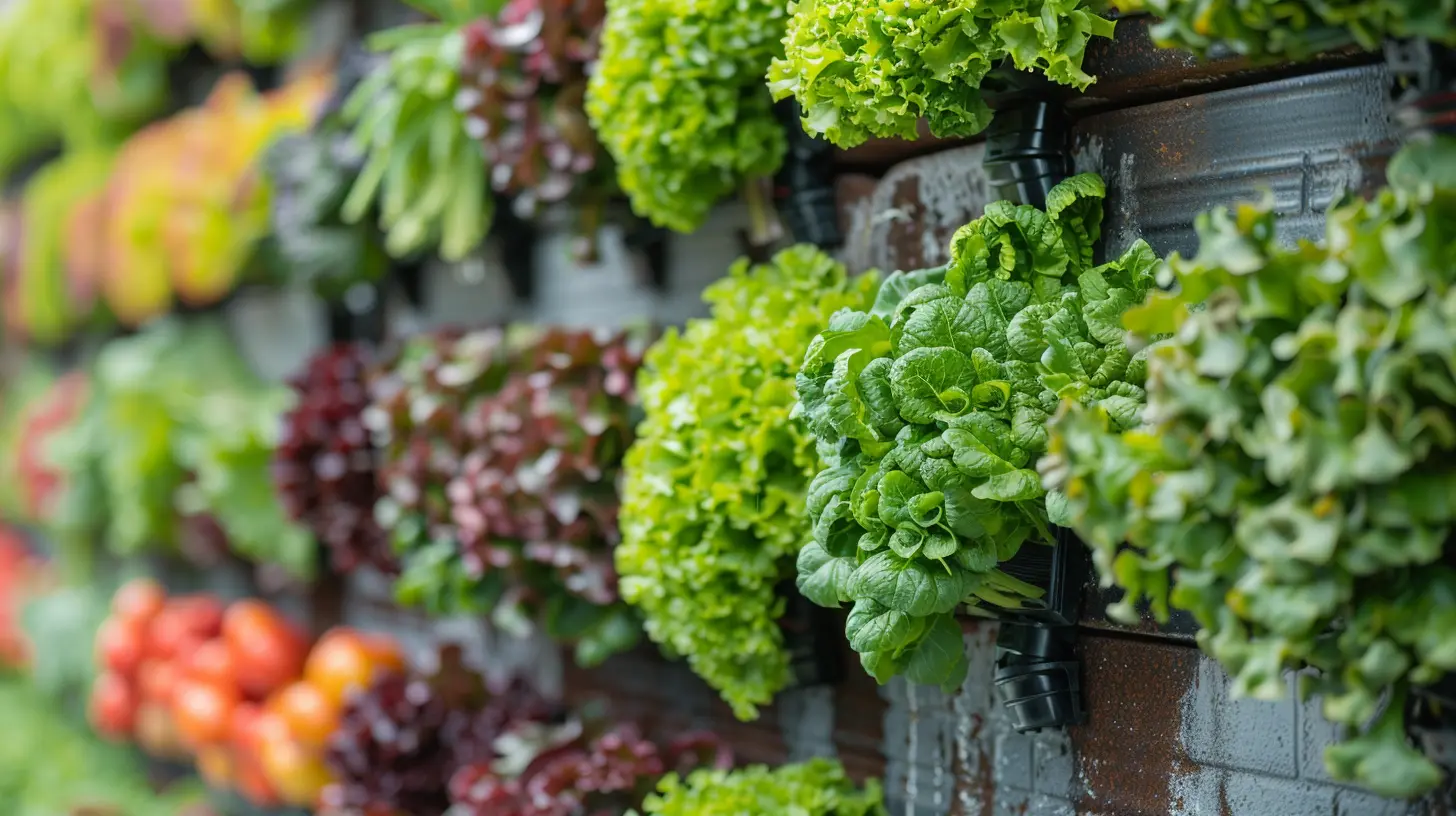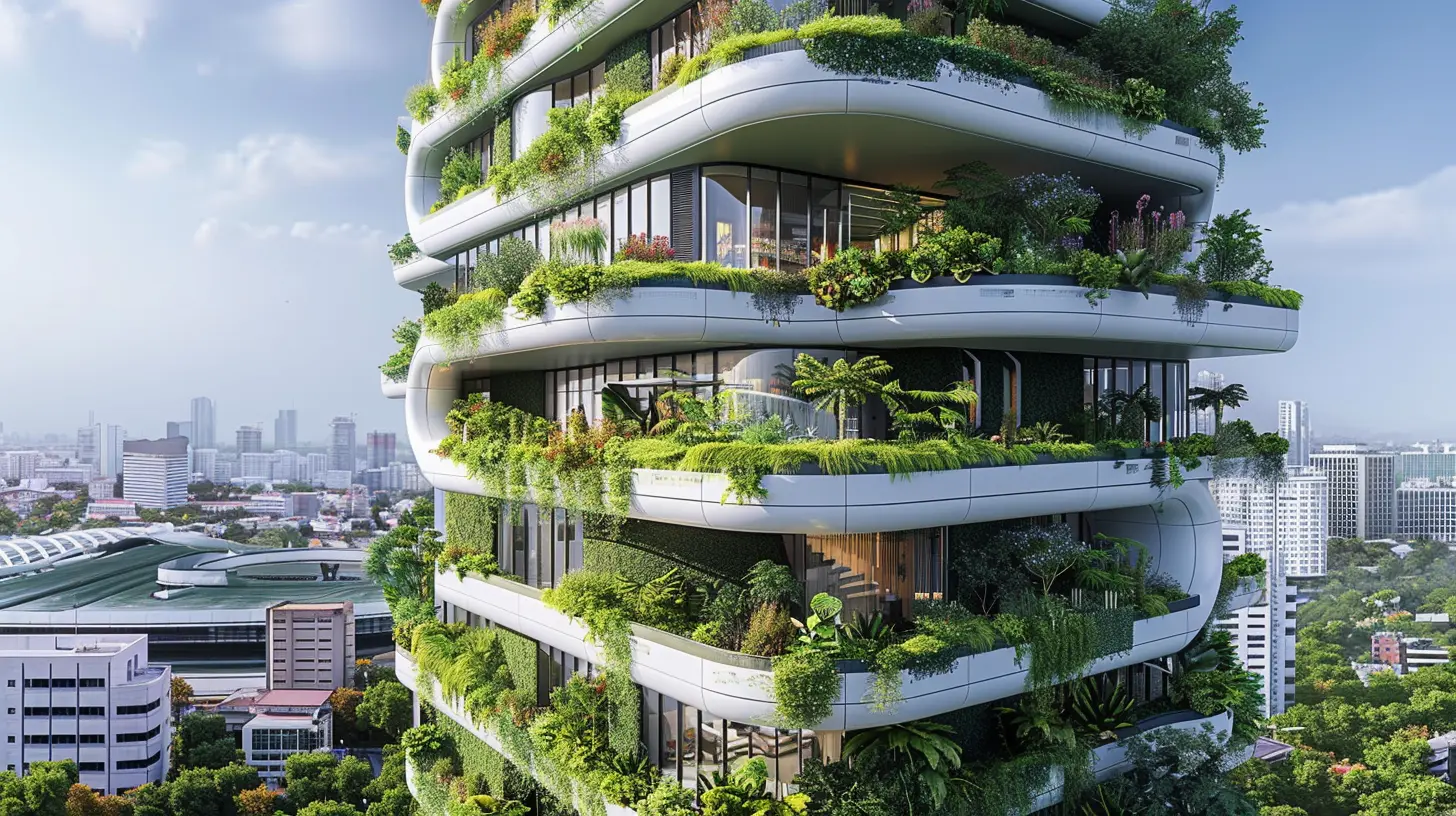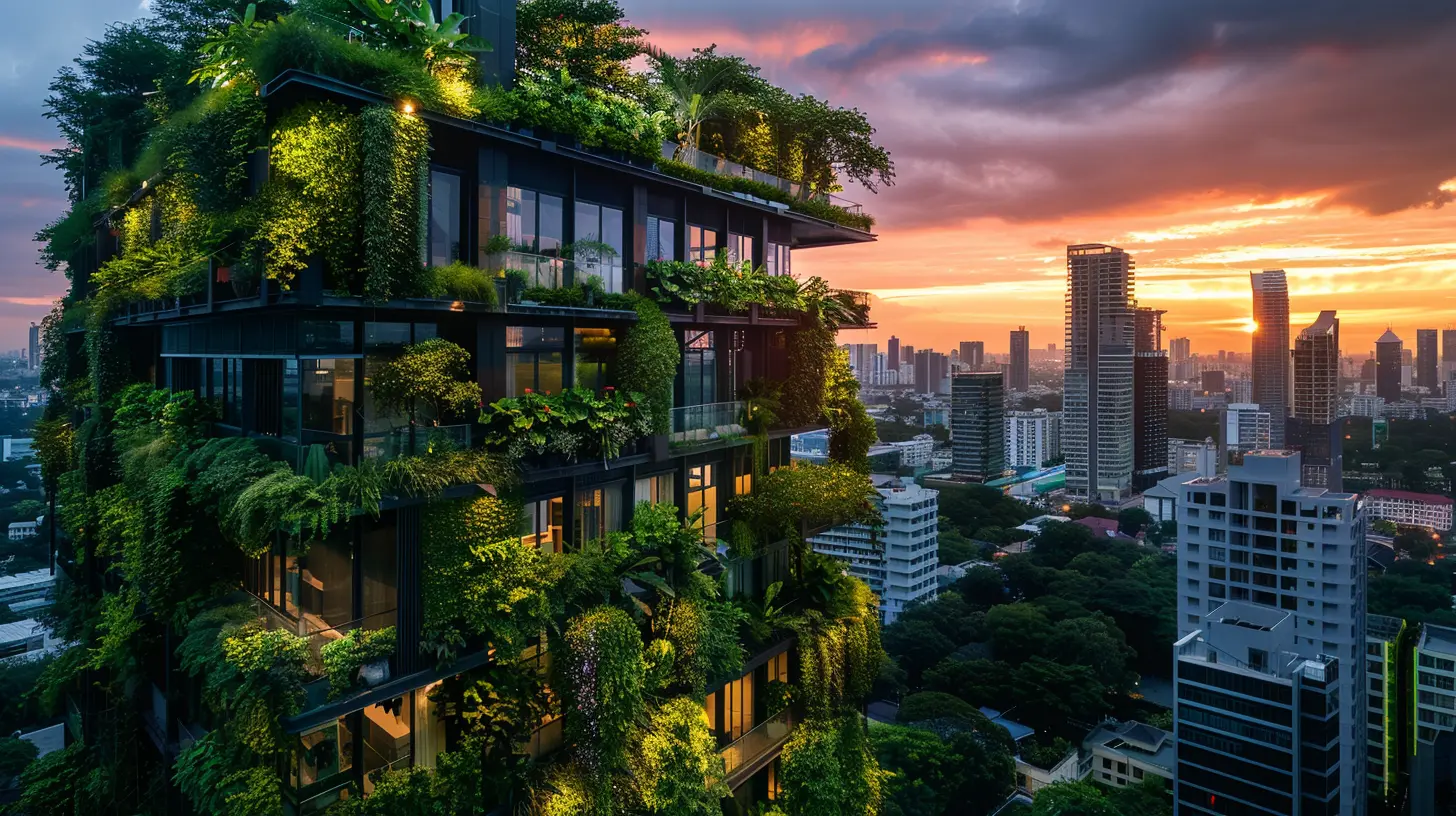Green Technology for Urban Farming: The Rise of Vertical Gardens
5 February 2025
As cities around the world continue to grow, so does the demand for food. But with this growth comes a critical challenge: where are we going to grow all this food? Urban spaces are crowded, and traditional farming methods require vast amounts of land. Enter green technology for urban farming and, more specifically, the rising trend of vertical gardens. In this article, we’ll dive into what vertical gardening is, how it's revolutionizing food production, and why it could be the future of sustainable urban agriculture.

What Exactly Are Vertical Gardens?
Before we get into the nitty-gritty, let’s start with the basics. Vertical gardens, as the name suggests, are gardens that grow plants vertically rather than horizontally. Imagine a tall wall covered in leafy greens, herbs, or even tomatoes. These gardens can be installed indoors or outdoors, on rooftops, or even on the sides of buildings. Pretty cool, right?The concept of vertical gardening is simple: instead of spreading plants across the ground, you stack them up in layers. This technique maximizes space, making it perfect for urban environments where land is limited. But it’s not just about saving space—vertical gardens are also an eco-friendly solution that addresses some of the major challenges faced by conventional farming.

The Urban Farming Revolution: Why Vertical Gardens Matter
Now, you might be wondering, why all the fuss about vertical gardens? Well, let’s face it: traditional farming methods just aren't cutting it anymore, especially in urban areas. Cities are sprawling, and arable land is becoming scarcer. Plus, long food supply chains lead to higher carbon emissions, food waste, and increased costs. Vertical gardens tackle these issues head-on by offering a sustainable, local solution to food production.In urban settings, vertical gardens make it possible to grow fresh produce right where it’s needed. That means fewer food miles, fresher veggies, and a reduced carbon footprint. Imagine being able to pick your salad greens from a vertical garden on your apartment balcony, or grabbing fresh herbs from a green wall at your local grocery store. Sounds like a dream, doesn’t it?

How Does Green Technology Fit In?
You might be wondering, "Okay, but what role does green technology play in all of this?" Well, green tech is the backbone of vertical farming. It’s what makes these gardens not only possible but also efficient and sustainable.1. Hydroponics: Farming Without Soil
One of the most common technologies used in vertical gardens is hydroponics. This is a method of growing plants without soil, using a nutrient-rich water solution instead. The roots of the plants are submerged in this solution, which provides all the nutrients they need to grow. This method uses significantly less water than traditional farming—up to 90% less! Plus, because there’s no soil involved, there’s no need for pesticides or herbicides, making it a more eco-friendly option.2. Aeroponics: Growing in the Air
Another cutting-edge technology used in vertical gardens is aeroponics. It’s similar to hydroponics, but instead of submerging the roots in water, the plants are suspended in the air, and their roots are misted with a nutrient solution. Aeroponics allows for even more efficient use of water and nutrients, making it ideal for urban farming where resources are often limited.3. LED Grow Lights: Mimicking the Sun
Sunlight can be hard to come by in dense urban environments, especially indoors. That’s where LED grow lights come in. These energy-efficient lights can be adjusted to provide the exact wavelength of light that plants need to photosynthesize and grow. Some vertical gardens even use smart lighting systems that can be controlled via smartphone apps. Talk about high-tech gardening!4. Automated Systems: Let the Tech Do the Work
Modern vertical gardens often come equipped with automated systems that handle tasks like watering, nutrient delivery, and light management. These systems take the guesswork out of gardening and make it easier for even the busiest urban dwellers to grow their own food. Some setups are so advanced that they can monitor the health of plants in real-time and adjust conditions as needed.
Benefits of Vertical Gardens: Why Should You Care?
Alright, so vertical gardens are pretty high-tech. But what does that mean for you and me? Well, there are plenty of reasons to get excited about this green technology, whether you’re a city dweller, a sustainability enthusiast, or just someone who loves fresh food.1. Maximized Space in Crowded Cities
Let’s be real: space is a luxury in most cities. With vertical gardens, you can grow a substantial amount of food in a small area. Whether it's a green wall on the side of a building or a stacked garden on a balcony, vertical gardening makes it possible to transform even the tiniest urban spaces into productive farming areas.2. Sustainable and Eco-Friendly
One of the major perks of vertical gardens is their environmental impact—or rather, the lack of it. By using less water, reducing the need for harmful chemicals, and cutting down on food transportation, vertical gardens significantly reduce the carbon footprint of urban agriculture. Plus, many vertical gardening systems are designed to be energy-efficient and sustainable, often powered by renewable energy sources like solar panels.3. Fresher Food, Closer to Home
There’s nothing quite like fresh, home-grown produce. With vertical gardens, you can grow your own fruits, veggies, and herbs right in your backyard—or even in your living room. This means no more buying wilted lettuce that’s been shipped halfway around the world. Instead, you get fresh, nutrient-rich food just steps away from your kitchen.4. Improved Air Quality
Did you know that vertical gardens can actually help improve air quality in urban areas? Plants naturally filter the air by absorbing pollutants and releasing oxygen. In fact, some vertical gardens are specifically designed as “living walls” that act as natural air purifiers. So not only do they look beautiful, but they also contribute to a healthier environment.5. Community Engagement and Wellbeing
Vertical gardens aren’t just about growing food—they’re also about fostering community. Many urban areas are embracing vertical gardening initiatives as a way to bring people together. Community gardens, rooftop farms, and green spaces can improve social cohesion, provide educational opportunities, and promote mental well-being. Plus, there’s something undeniably satisfying about watching something grow, isn’t there?Challenges of Vertical Gardens: It’s Not All Roses
As great as vertical gardens are, they’re not without their challenges. But hey, what innovation doesn’t have a few bumps along the way?1. Initial Costs
Setting up a vertical garden, especially one that incorporates advanced technologies like hydroponics and automated systems, can be expensive. While the long-term benefits can outweigh the initial investment, the upfront costs might be a barrier for some individuals or communities.2. Maintenance
While modern vertical gardens come with automated systems, they still require some level of maintenance. If you’re not the type to keep a regular eye on things, plants could die, systems could fail, or nutrient levels could drop. In other words, it’s not completely "set it and forget it."3. Energy Use
Although vertical gardens can save water and reduce pesticide use, systems that rely heavily on artificial lighting and automation can consume energy, especially if they’re not powered by renewable sources. However, many vertical gardening systems are working toward energy efficiency, and the integration of solar panels or other renewable energy sources can help offset this.
The Future of Vertical Gardening
So, where do we go from here? Well, the future of vertical gardening looks bright—literally and figuratively. As technology continues to evolve, we can expect to see even more innovative solutions for urban farming. From smart gardens that can be controlled via smartphone to large-scale vertical farms that supply entire cities, the possibilities are endless.There’s also a growing interest in integrating vertical gardens into urban planning. Imagine entire buildings covered in greenery, or city parks that double as vertical farms. Not only would these spaces provide fresh food, but they could also create a more sustainable, beautiful, and livable city environment.
Conclusion
In a world where urbanization is rapidly increasing and the demand for sustainable food production is more urgent than ever, vertical gardens offer a green solution that could reshape the future of urban farming. They’re not just a passing trend—they’re a glimpse into what’s possible when technology meets nature. Whether you’re looking to grow a few herbs on your balcony or you’re dreaming of a city covered in green walls, vertical gardens are a smart, eco-friendly way to bring farming back to urban spaces.So, next time you look out at the concrete jungle, imagine what it could look like with a little more green. Who knows? The future of farming might just be right outside your window.
all images in this post were generated using AI tools
Category:
Green TechnologyAuthor:

Michael Robinson
Discussion
rate this article
21 comments
Serenity McIlroy
Vertical gardens are a sustainable solution for urban food production!
April 8, 2025 at 12:32 PM

Michael Robinson
Absolutely! Vertical gardens maximize space, enhance biodiversity, and reduce urban heat, making them an ideal solution for sustainable urban food production.
Emma Romero
Vertical gardens exemplify innovation in urban farming, merging sustainability with aesthetics, and transforming city landscapes while promoting biodiversity and healthy living.
March 9, 2025 at 5:18 AM

Michael Robinson
Thank you for highlighting the multifaceted benefits of vertical gardens! They truly represent a harmonious blend of innovation, sustainability, and improved urban living.
Greyson Brown
Vertical gardens are revolutionizing urban farming, merging sustainability and innovation to transform our cities into green spaces.
March 7, 2025 at 11:43 AM

Michael Robinson
Thank you! Vertical gardens indeed offer a groundbreaking approach to urban farming, enhancing sustainability and beautifying our cities.
Lillian Newton
Great insights on vertical gardens! It's inspiring to see how green technology is transforming urban farming and enhancing our cities. Keep it up!
March 5, 2025 at 8:26 PM

Michael Robinson
Thank you! I’m glad you found the insights inspiring. Together, we can cultivate greener cities!
Kathleen McAdoo
Vertical gardens: where plants are the skyscrapers of the future! 🌿💚 Who knew that lettuce could have a penthouse view? Let's hope these leafy green giants help us thrive in the concrete jungle—after all, even our veggies deserve an upgrade in their living situation! 🌆🥬 #UrbanFarming
March 4, 2025 at 11:35 AM

Michael Robinson
Absolutely! Vertical gardens not only beautify urban spaces but also promote sustainability and provide fresh produce right where we need it. 🌱🌍
Izaak McMahon
The emergence of vertical gardens represents a pivotal shift in urban farming, blending technology with sustainability. By optimizing space and resources, these green innovations not only enhance urban aesthetics but also contribute to food security and environmental health. As cities grow, vertical gardens could be key in promoting sustainable urban lifestyles.
February 24, 2025 at 8:40 PM

Michael Robinson
Thank you! I completely agree—vertical gardens are indeed transforming urban spaces, offering sustainable solutions that enhance both aesthetics and food security. Their role in promoting greener lifestyles is crucial as cities continue to expand.
Paige Mathews
Great insights on the potential of vertical gardens! Integrating green technology in urban farming not only enhances sustainability but also improves city aesthetics. It would be interesting to explore specific case studies showing successful implementations and their impact on local communities. Keep up the good work!
February 23, 2025 at 1:35 PM

Michael Robinson
Thank you for your insightful comment! I agree that case studies can showcase the real impact of vertical gardens on communities. I’ll consider including them in future discussions.
Sebastian McMillen
Innovative and inspiring! Vertical gardens truly transform urban living sustainably.
February 21, 2025 at 11:20 AM

Michael Robinson
Thank you! I'm glad you found the article inspiring. Vertical gardens indeed offer a sustainable solution for urban living!
Presley Price
Vertical gardens: because who doesn’t want to grow their salad 10 feet above a taxi? Finally, a way to make urban farming feel like gardening in a luxury skyscraper—just watch out for hungry pigeons aiming for those organic tomatoes!
February 19, 2025 at 7:17 PM

Michael Robinson
Absolutely! Vertical gardens not only maximize space but also bring a touch of nature to urban settings—just be sure to keep those tomatoes safe from our feathered friends!
Viva Rhodes
Vertical gardens: where eco-consciousness meets urban elegance.
February 18, 2025 at 1:06 PM

Michael Robinson
Thank you! Vertical gardens truly blend sustainability with style, transforming urban spaces while promoting eco-friendly practices.
Flora Powell
This article highlights the transformative potential of vertical gardens in urban farming, showcasing how green technology can enhance sustainability, improve air quality, and revolutionize food production in cities.
February 17, 2025 at 9:57 PM

Michael Robinson
Thank you for your insightful comment! Indeed, vertical gardens represent a significant leap toward sustainable urban living and food production.
Fennec McKnight
“Vertical gardens: where veggies climb higher than my caffeine level!” 🌱🚀
February 17, 2025 at 4:05 AM

Michael Robinson
Absolutely! Vertical gardens not only elevate plants but also our sustainable urban living!" 🌿✨
Sorin Gonzalez
Great article! The rise of vertical gardens is an inspiring solution for urban farming. It’s exciting to see how green technology can transform our cities, promote sustainability, and provide fresh produce within limited spaces. Keep up the fantastic work in raising awareness!
February 16, 2025 at 12:07 PM

Michael Robinson
Thank you! I'm glad you found the article inspiring. Vertical gardens truly have the potential to revolutionize urban farming and sustainability. Your support means a lot!
Presley McWain
Great insights on vertical gardens! Excited to see how green technology transforms urban farming practices.
February 14, 2025 at 12:52 PM

Michael Robinson
Thank you! I'm glad you found the insights valuable. Exciting times ahead for urban farming!
Harmony McElhinney
Grow green, thrive urban life!
February 13, 2025 at 9:57 PM

Michael Robinson
Thank you! Embracing green technology in urban farming truly fosters sustainable, vibrant communities.
Amy Ruiz
“Who knew stacking plants could be the next big thing? Vertical gardens are like the skyscrapers of the plant world—bringing a whole new meaning to ‘high maintenance’ in urban farming!”
February 11, 2025 at 9:22 PM

Michael Robinson
Absolutely! Vertical gardens are revolutionizing urban spaces, combining aesthetics with sustainability—truly a green skyscraper trend!
Arwenia O'Brien
Vertical gardens are revolutionizing urban farming! By blending sustainability with innovation, we can transform cities into green spaces, improve air quality, and foster community resilience. Let’s cultivate a greener future together!
February 10, 2025 at 4:04 AM

Michael Robinson
Absolutely! Vertical gardens are a game-changer for urban farming, enhancing sustainability, air quality, and community well-being. Together, we can create thriving green spaces in our cities!
Fenn McDaniel
Grow up, not out—literally!
February 7, 2025 at 4:34 AM

Michael Robinson
Thank you for your comment! Vertical gardens indeed offer a smart solution for maximizing space while promoting sustainability.
Elizabeth McMillan
Vertical gardens represent a significant advancement in urban farming, utilizing limited space efficiently while promoting sustainability. By integrating green technology, they enhance food production, improve air quality, and contribute to biodiversity in urban environments, aligning with contemporary ecological and agricultural goals.
February 5, 2025 at 7:59 PM

Michael Robinson
Thank you for your insightful comment! Vertical gardens indeed play a crucial role in maximizing urban space, enhancing sustainability, and supporting biodiversity.
Phoenix McKellar
Vertical gardens represent a transformative approach to urban farming, leveraging limited space and resources. By promoting biodiversity and reducing carbon footprints, they can enhance city sustainability and food security.
February 5, 2025 at 12:38 PM

Michael Robinson
Thank you for highlighting the benefits of vertical gardens! They truly are a game-changer for urban sustainability and biodiversity.
Celeste McCool
This article highlights the innovative impact of vertical gardens on urban farming. Green technology not only optimizes space but also promotes sustainability, enhancing city life and food production efficiency. Great insights!
February 5, 2025 at 4:14 AM

Michael Robinson
Thank you for your feedback! I'm glad you found the insights on vertical gardens and their role in urban farming and sustainability valuable.
MORE POSTS

Blockchain's Role in the Internet of Things (IoT)

The Role of Wearable Devices in Monitoring Air Quality

Blockchain and Real Estate: Tokenizing Property Ownership

Rugged Outdoor Gadgets for the Ultimate Adventure Seeker

How to Create Captivating Animations with These Easy-to-Use Tools

How Smart Cities Are Integrating Green Technology

How Wearables are Pushing the Boundaries of Sustainable Health Tech

Mastering Content Creation with These Powerful Editing Tools

Virtual Reality and Cinematic Experiences: The Future of Movie Watching

Why Tech Startups Should Focus on Customer Experience from Day One

The Cybersecurity Risks of BYOD (Bring Your Own Device) Policies

How Templates and Presets Can Revolutionize Your Content Workflow

The Importance of Security Audits and Vulnerability Assessments